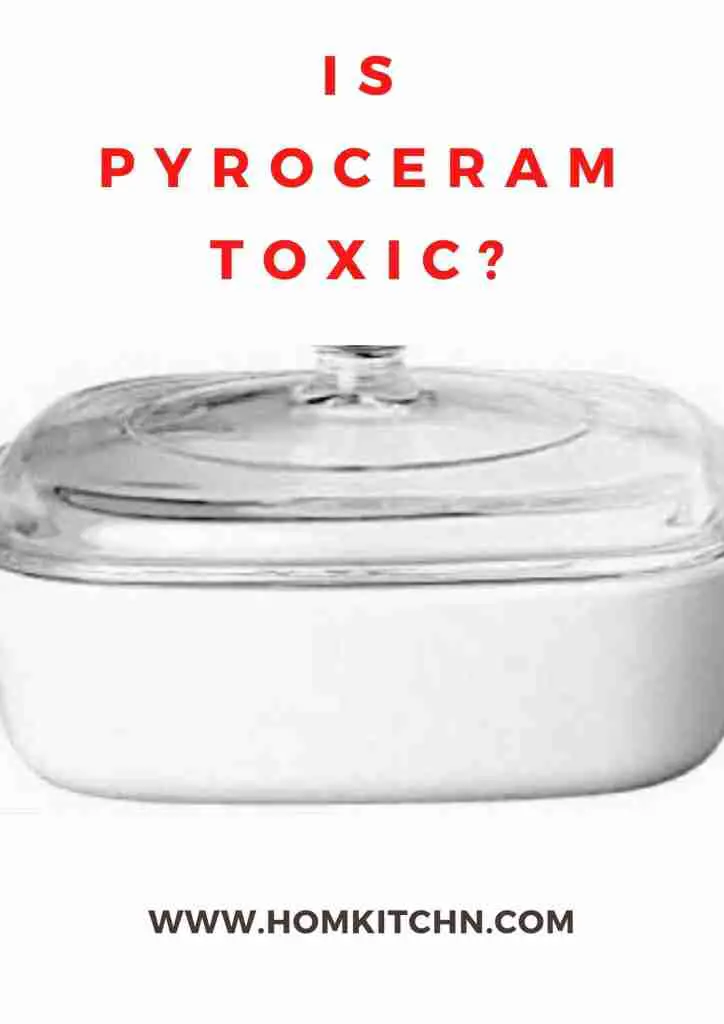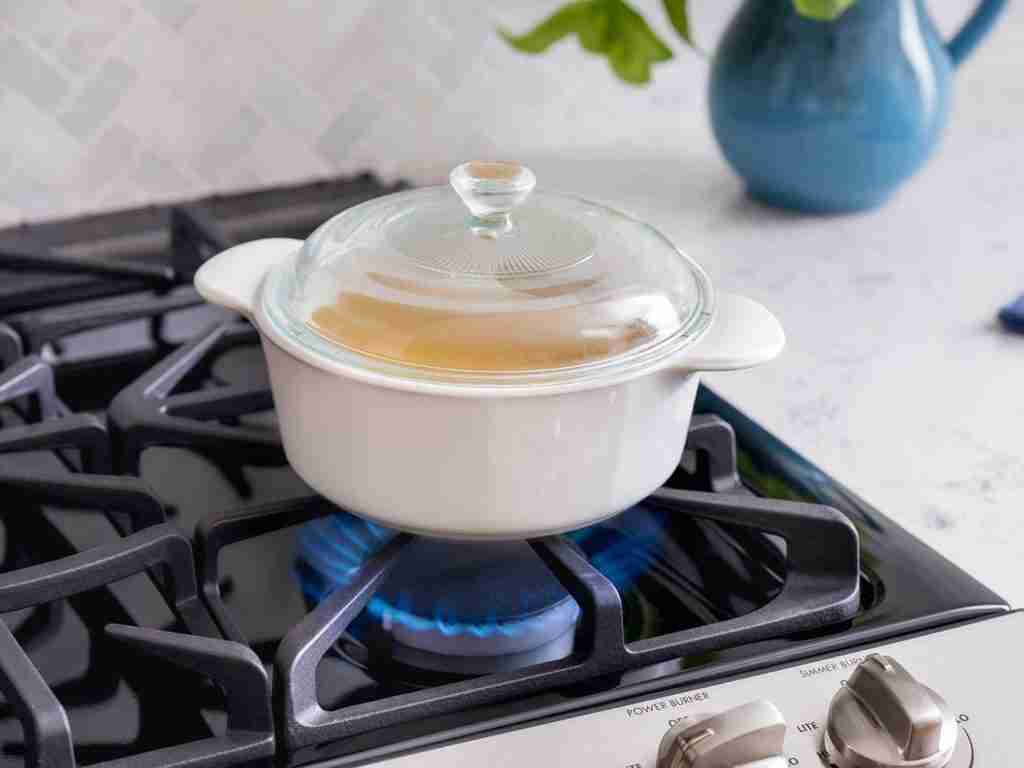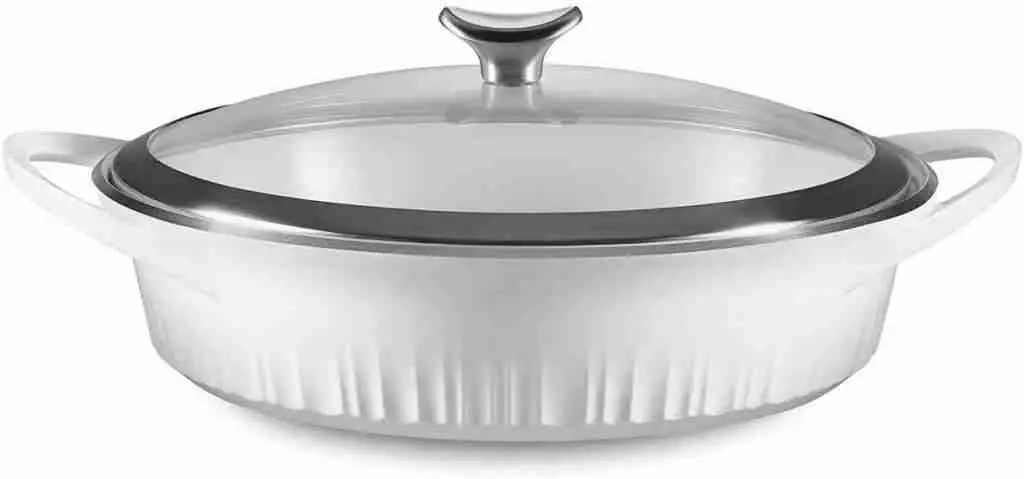Is Pyroceram toxic? Toxic chemicals are all around in our environment, homes, and consumer products we use every day.
But the good news is that doesn’t have to be exposed to them or get pricked from them. We can actually avoid them by doing the right things.
We can do this by choosing nontoxic cookware. This in turn will remove toxic things from our homes and chemicals from our bodies.
Finally, we can live the happy, fulfilling and healthy life that we’ve always wanted for ourselves and our families.
Now, let’s talk about Pyroceram. Is it toxic? Does it leach harmful chemicals into food? Is it safe for you and your loved ones?
IS PYROCERAM SAFE?
Pyroceram is safe to use because the material used to make Corningware is eco-friendly, does not leach into food, is non-toxic, and can withstand the thermal shock of sudden temperature up to 450 °C (840 °F).
CORNING PYROCERAM
Pyroceram is a material used in the production of Corningware, which is why it is known as Corning Pyroceram. Corning Glass began developing glass-ceramic material, which is now a trademark, in the 1950s.
Corning Pyroceram glass-ceramic material is opaque and light gray in color, with high strength, elastic modulus, and uniform dielectric properties. It is available in ogival shapes, hemispheres, press ware sheets, and a variety of machined shapes.
Corning Pyroceram was discovered in 1953 by .S. Donald Stookey while conducting research on a photosensitive lithium silicate glass called Fotoform containing a dispersion of silver nanoparticles. Stookey noticed that an accidentally overheated fragment of the glass resisted breakage when dropped.
This discovery evolved into Pyroceram, which was used in the production of Corningware cookware in 1958. Pyroceram has excellent thermal stability and a low coefficient of thermal expansion.
Furthermore, Pyroceram was improved upon, particularly in the manufacture of cookware, giving rise to Corning France’s Visions cookware in the late 1970s.
Corning Pyroceram can be used in a variety of applications, including cookware, kitchenware, glass stovetops, and wood stove doors. It can also be used in Tactical Missile Nosecones, Antenna Windows, Radomes, Solid Wave Guides, and Hydrospace Systems.
RELATED: VISIONS COOKWARE LEAD
IS PYROCERAM TOXIC?

No! Pyroceram is non-toxic because it is made of an Original Opaque non-porous, white glass-ceramic material (similar to bone china) that has high heat tolerance, low thermal expansion, does not warp when exposed to high temperatures of a stove or oven, will never harbor food odors, and will never leach harmful chemicals into your meals.
WHO INVENTED CORNINGWARE?
Donald Stookey is credited with inventing Corningware after inadvertently creating a synthetic ceramic glass material called Pyrcoeram in the 1950s during an experiment that resulted in Corningware. Corningware is known for its ability to withstand high temperatures, making it ideal for casserole dishes that can go from oven to table and then into the refrigerator or freezer.
IS CORNINGWARE DANGEROUS?
No! Corningware cookware, according to Corningware, has a completely non-reactive surface, does not retain odors and food particles, and is therefore harmless to our health because it is made of a highly heat resistant durable Pyroceram glass-ceramic material.
CORNINGWARE COOKWARE

Corningware is versatile and universal cookware. Corningware cookware is designed with the customer in mind; this versatile perfect cookware can store your food, be used for cooking on a variety of stovetops, and be frozen due to its thermal shock properties.
Unlike other cookware, the Corningware Cookware retains heat much longer, allowing you to eat your meal without having to re-warm it, saving you energy. Second, the Corningware cookware performs admirably on lower heat settings.
Corningware cookware is available in a variety of designs and collections, giving customers a variety of options. The eye-catching feature of Corningware cookware is that it allows the user to easily and confidently transport food from the freezer to the stovetop or oven and then to the dining table.
Corningware is committed to providing one-stop cookware that is convenient, easy to clean, long-lasting, hygienic, and safe for everyone to use!
IS VINTAGE CORNINGWARE OVEN-SAFE?
Yes, the Vintage Corningware is oven safe because it is made of Pyroceram, a thermally resistant material that can withstand oven and microwave use.
IS CORNINGWARE MADE IN CHINA?
Although Corning’s headquarters are in the United States, not all Corningware products are manufactured there. The newer Corningware cookware, which is made of stoneware, is manufactured in China.
While the original Corningware, particularly the “French white pattern,” is made in the United States and was manufactured from 1978 to 2001.
CORNINGWARE FRENCH WHITE
Corningware the Corelle Brand’s French white cookware is one of its most popular product lines. They are useful for a variety of tasks, including cooking, serving, and even freezing cooked meals.

The majority of Corningware French White cookware is made of the Original Pyroceram, stoneware, or aluminum. Stoneware Corningware French white is a multi-purpose Dutch oven/casserole dish that is oven, microwave, refrigerator, and freezer safe.
Stoneware Corningware French White is also ideal for even heating, especially on a variety of heat sources, but keep in mind that not all Corningware French White can be used on an induction cooktop; contact the manufacturer or read the product description for more information.
Corningware the French White material is resistant to chipping and cracking and even scratched Corningware is safe to use.
The Corningware French white dish has a non-porous surface that does not absorb food odors or flavors, is lead and cadmium free, and does not absorb stains.

Corningware French White is easy to care for, clean and has a nonstick ceramic interior.
Corningware French White Glass lids make cooking, serving, and storing a breeze.
This table-ready Corningware French White tastefully designed durable ceramic cookware can transition from cooking to table-ready presentation is recommended.
CORNINGWARE LEAD WARNING
There have been numerous debates about the presence of lead in Corningware. Some argue that the old vintage Corningware contains traces of lead and cadmium, while others claim that the newly manufactured ones do.
Who are we to believe? While Corningware has stated that its products are designed with safety in mind to protect the consumer’s health, others believe that this is not entirely true.
Before we decide whether Corningware contains lead, keep in mind that any cookware or dinnerware that complies with the FDA and California 65 Proposition is considered safe because the amount of leachable content is less than the specified standard.
As previously stated, Pyroceram is non-toxic and safe for use, and stoneware, as a ceramic material, poses fewer health risks.
To be certain that you eat and serve food with confidence, we recommend performing a lead test with an XRF instrument to determine the lead level of the Corningware cookware.
For the Lead test, you must inspect both the inside and outside of the Corningware cookware for proper diagnosis before you can conclude what model, year, and type of Corningware cookware has any trace of lead.
WHAT MATERIAL IS CORNINMGWARE MADE OF?
The Old Corningware is made up of Pyroceram material while the New Corningware is made up of Stoneware material part of the Ceramic material.
DOES CORNING STILL MAKE PYROCERAM?
Originally made primarily in the United States, production of Pyroceram-based Corning Ware in the United States ceased with the closure of the Martinsburg, West Virginia plant. While production in France continued, the product was temporarily unavailable in the United States, and the brand was relaunched in 2001 as a line of stoneware-based bakeware.
Corningware StoveTop, a Pyroceram-based line, was also reintroduced in the United States in December 2008.
Keraglass/Eurokera, a partnership between Corning and Saint-Gobain that specializes in Vitroceramics for cooktop panels and laboratory equipment in Bagneaux-Sur-Loing, France, is one of the factories in the world that still manufactures Pyroceram-based cookware.
PYREX VS CORNINGWARE
To begin, both Pyrex and Corningware are manufactured by the same parent company, World Kitchen or Corelle Brand.
The following are the distinctions between the Pyrex and Corningware Corelle product lines:
Pyrex is a brand introduced by Corning Inc. in 1915, it has a low thermal expansion, is made of Borosilicate glass, and is used in the manufacturing of kitchenware and laboratory glassware, whereas Corningware was first introduced by Corning in 1958, it is resistant to thermal shock, and is made of a unique glass-ceramic Pyroceram material used in the manufacturing of cookware and other types of equipment.